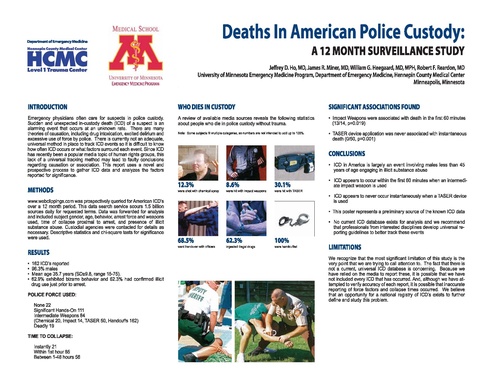Taser Death in American Police Custody Study 2005
Download original document:

Document text

Document text
This text is machine-read, and may contain errors. Check the original document to verify accuracy.
Deaths In American Police Custody: MEDICAL SCHOOL A12 MONTH SURVEILLANCE STUDY Jeffrey D. Ho, MD, James R. Miner, MD, William G. Heegaard, MD, MPH, Robert F. Reardon, MD University of Minnesota Emergency Medicine Program, Department of Emergency Medicine, Hennepin County Medical Center Minneapolis, Minnesota UNIVERSITY OF 1111 NESOTA EMERGENCY MEDICINE PROGRAM INTRODUCTION WHO DIES IN CUSTODY SIGNIFICANT ASSOCIATIONS FOUND Emergency physicians often care for suspects in police custody. Sudden and unexpected in-custody death (ICD) of a suspect is an alarming event that occurs at an unknown rate. There are many theories of causation, including drug intoxication, excited delirium and excessive use of force by police. There is currently not an adequate, universal method in place to track ICD events so it is difficult to know how often ICD occurs or what factors surround each event. Since ICD has recently been a popular media topic of human rights groups, this lack of a universal tracking method may lead to faulty conclusions regarding causation or association. This report uses a novel and prospective process to gather ICD data and analyzes the factors reported for significance. A review of available media sources reveals the following statistics about people who die in police custody without trauma. • Impact Weapons were associated with death in the first 60 minutes (13114, p=0.019) Note: Some subjects fit multiple categories, so numbers are not intended to add up to 100%. • TASER device application was never associated with instantaneous death (0/50, p=0.001) METHODS www.webclippings.com was prospectively queried for American lCD's over a 12 month period. This data search service scours 1.5 billion sources daily for requested terms. Data was forwarded for analysis and included subject gender, age, behavior, arrest force and weapons used, time of collapse proximal to arrest, and presence of illicit substance abuse. Custodial agencies were contacted for details as necessary. Descriptive statistics and chi-square tests for significance were used. RESULTS • • • • 162 lCD's reported 96.3% males Mean age 35.7 years (SD±9.8, range 15-75). 62.9% exhibited bizarre behavior and 62.3% had confirmed illicit drug use just prior to arrest. POLICE FORCE USED: None 22 Significant Hands-On 111 Intermediate Weapons 84 (Chemical 20, Impact 14, TASER 50, Handcuffs 162) Deadly 19 TIME TO COLLAPSE: Instantly 21 Within 1st hour 85 Between 1-48 hours 56 CONCLUSIONS • ICD in America is largely an event involving males less than 45 years of age engaging in illicit substance abuse 12.3% 8.6% were shot with chemical spray were hij wnh impact weapons ....... ... ~ • ICD appears to occur within the first 60 minutes when an intermediate impact weapon is used were hit with TASER • ICD appears to never occur instantaneously when a TASER device is used "'- .. ill'- • This poster represents a preliminary source of the known ICD data • No current ICD database exists for analysis and we recommend that professionals from interested disciplines develop universal reporting guidelines to better track these events JIlt 68.5% 62.3% 100% went hands-on with officers ingested illegal drugs were handcuffed LIMITATIONS We recognize that the most significant limitation of this study is the very point that we are trying to call attention to. The fact that there is not a current, universal ICD database is concerning. Because we have relied on the media to report these, it is possible that we have not included every ICD that has occurred. And, although we have attempted to verify accuracy of each report, it is possible that inaccurate reporting of force factors and collapse times occurred. We believe that an opportunity for a national registry of lCD's exists to further define and study this problem.

